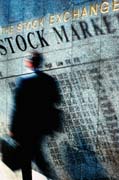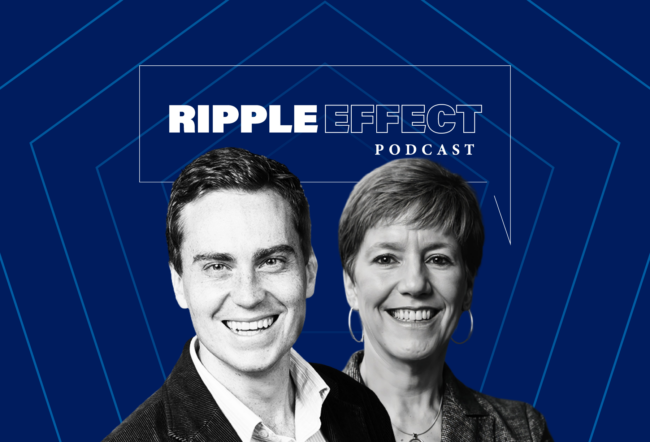Are the good times really over, or should investors expect stocks to resume their course of seemingly inevitable long-term gains? It depends whom you ask, of course. After the bubble of the late ‘90s, stocks are still over-priced and could fall dramatically, says
Jeremy J. Siegel, Wharton finance professor and author of Stocks for the Long Run, believes the 2000-2001 downturn has returned stocks to rational levels and that stocks’ long-term gains should continue to beat alternatives like bonds and cash.
The professors debated the market’s current condition on April 16 as part of The Ashish and Sapna Shah Speaker Series. Many in the audience might have anticipated a showdown at an event titled “Two Views of Asset Markets: Are Stocks Still Right for the Long Run?” But Shiller and Siegel are collegial adversaries. They are former graduate school classmates who have vacationed together, and Shiller told the audience he had written Irrational Exuberance at Siegel’s urging.
Joking that Siegel’s book was responsible for the stock market bubble, Shiller said, “You have to do something different in your next book, because 96% of the people already agree with your conclusion.” His own book, published just as the market hit its all-time peak in March 2000, is, “the kind of book a commission would write for a president who asked for an explanation of the boom,” Shiller said.
Displaying a stock market chart from 1871 to the present, Shiller noted that the late 1990s-early-2000 stock spike far exceeded the growth of corporate earnings. “Notice that it’s only happened one time before,” he added, pointing to a peak that preceded the 1929 crash.
By March 2000, he said, the ratio of stock prices to a moving average of per-share earnings over the previous 10 years had reached a staggering 45, about triple the historical level. While the price decline of the past year has brought this P/E ratio down somewhat, “it’s about where it was in 1929 now.”
High P/E ratios mean investors are investing with an eye not so much on current earnings as on future ones, which they expect to be much higher. The continuing high P/E ratio suggests investors believe the economy is in a new era in which soaring productivity will lead to rapid earnings growth, Shiller said. But historically, he added, “productivity grows in a very slow way.
“It’s not a new era; it’s something old called a speculative bubble that has driven the market,” he said. Among the factors generating this investor enthusiasm was the mid ‘90s development of the world wide web. “It created a kind of business that seemed to have no upward bound.”
Enthusiasm bred more enthusiasm, and rising stock prices encouraged investors to bid stocks up even further in a “self-fulfilling prophecy, a feed-back loop,” he said. “We had a naturally occurring story in the Internet which created the same effect as a Ponzi scheme.
“I believe that every speculative bubble in history has essentially been managed by the media,” Shiller added. In cases going back as far as the famous tulip mania in Holland in the 1630s, the spreading news of staggering profits has fueled further speculation. Those sounding warnings are typically drowned out by others who assert that the old rules no longer apply. “Lo and behold, they always had a new-era theory.”
Other factors in bubbles, he said, are “anchoring” and “attention anomalies” – human tendencies to exaggerate the lessons to be drawn from recent experience and to focus on the wrong things. Thus, investors think that if stocks have gone up, they must continue to go up; and they ignore indications that prices are unreasonably high.
Eventually, bubbles burst when investors realize the old rules do apply, he said. Internet stocks collapsed in 2000 when investors concluded that many of these companies would never show profits.
Despite the downturn of 2000 and early 2001, stock prices are still abnormally high by standard measures, such as price-to-earnings ratios. “The outlook for the market is not very good,” Shiller concluded.
Taking the lectern from Shiller, Siegel joked that, given the market’s collapse in the past year, the next edition of his Stocks for the Long Run might be subtitled Cash for the Short Run. Nonetheless, he said he remains bullish on stocks, which have consistently outperformed alternative investments such as bonds, cash and gold for two centuries, providing an average annual return of 7% above the inflation rate.
Still, he acknowledged, “there can be long periods of time when you’re not going to get 7%. From 1966 through 1981, annual returns averaged –0.4%. Then they jumped to 12.1% from 1982 through 2000.”
Bonds had returned an average of 3.5% above inflation for 200 years, but that rate declined in the late 20th century, making stocks look even better by comparison. While much has been made of the risky nature of stocks, they are actually less risky than bonds over periods of 30 years or more, because inflation is more damaging to bonds, Siegel said.
Since 1870, Siegel said, stocks’ P/E ratio has averaged 14.2. While the P/E for the 500 stocks in the Standard & Poor’s 500 index is now at a historically high level in the low 20s, most of the excess is caused by the even higher P/Es of the 80 major technology stocks in the index. The remaining 420 stocks have an average ratio of 18, which is “well within” the normal range over the long term. “Take out the techs and you really don’t have much of a bubble,” he said.
Reversing the P/E equation to instead divide earnings by price shows that the “earnings yield” has averaged 7% for 200 years. In other words, every dollar an investor spends on a stock yields 7 cents in earnings, just as putting a dollar into a 3% savings account would earn a depositor 3 cents in annual interest.
With the S&P 500’s P/E around 21, the earnings yield today is a modest 4.7%, only 1.2 percentage points more than one can earn on a safe inflation-indexed government bond, Siegel said. With earnings yields on stocks this low, investors are settling for very little premium in exchange for taking on the supposed risks of owning stocks.
Rather than being foolish, investors have come to a rational conclusion that stocks aren’t as risky as people used to think they were, he said. Stocks have proven to be good long-term investments despite short-term risks. Moreover, the cost of owning stocks has declined dramatically and investors therefore no longer need an extra margin of return simply to pay costs. Trading commissions and capital gains tax rates are now very low. Most companies currently use profits for reinvestment or stock buybacks rather than raising dividends, so that investors’ profits come primarily from share-price increases. These profits are taxed at lower rates than dividends. Also, the proliferation of mutual funds, and especially of low-fee index funds, drastically reduce the cost of owning and maintaining a diversified portfolio.
If risks aren’t as high as once thought and costs have fallen, it’s reasonable for investors to settle for a 4.7% earnings yield. Flipping that over again (100 / 4.7) shows that the current P/E ratio of the S&P 500 is quite reasonable at 21. Siegel added, however, that it is not certain that stocks can continue to rise at 7% above inflation. Growth in economic output, which fuels earnings growth and stock gains, could be limited by the economy’s rate of capital growth. It is possible, however, that technological advances may make output grow faster than capital. He noted that 90% of Microsoft Corp.’s value comes from its intellectual capital rather than buildings, factories and other traditional types of capital. “It’s still way too early to say we’ve shifted the paradigm,” he said.
In an exchange after their presentations, Shiller and Siegel each conceded the other had some points. “I think he has a point about P/Es,” Shiller said, adding that he expected to invest in stocks again one day. But he questioned whether investor psychology is really influenced by factors such as tax rates and trading costs, and he noted many past periods in which corporate earnings growth has stalled.
Siegel agreed that psychology “is by far the dominant factor in the short run.” Even if a P/E ratio in the low 20s is justified, psychological factors could drive the market “a lot lower,” he warned.
Even in the long run, he said, investors cannot be certain they will receive the 7% after-inflation returns they enjoyed in the past. Nonetheless, he concluded, stocks should continue to beat bonds and cash, making them the best bet for long-term investors.



